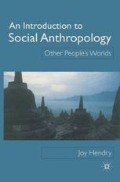Abstract
In the last two chapters we dipped our toes into some of the deeper issues anthropologists address, but we also glimpsed a little of the way an anthropological approach can contribute to an understanding of subjects of wider interest. In this final chapter we take up this theme again in reference to the contribution anthropologists can make and have made to the study of economics and the environment. While doing this, we shall draw together elements of anthropological work that we have considered throughout the book, and demonstrate how a good understanding of social (and economic) life depends on an understanding of the systems of classification and notions of exchange which we introduced at the outset.
Preview
Unable to display preview. Download preview PDF.
References
Appadurai, Arjun (1986) The Social Life of Things: Commodities in Cultural Perspective (Cambridge University Press).
Asquith Pamela and Arne Kalland (1997) Japanese Images of Nature: Cultural Perspectives (London: Curzon).
Barnard, Alan and James Woodburn (1988) ‘Property, power and ideology in hunter-gathering societies: an introduction’, in Ingold et al., Hunter-Gatherers (Oxford: Berg) pp. 4–31.
Barnes, R H. (1996) Sea Hunters of Indonesia: Fishers and Weavers of Lamalera (Oxford: Clarendon).
Campbell, J. K. (1964) Honour, Family and Patronage (Oxford: Clarendon).
Douglas, Mary and Baron Isherwood (1979) The World of Goods: towards an Anthropology of Consumption (London and New York: Routledge).
Einarrson, Niels (1993) ‘All animals are equal, but some are cetaceans: conservation and culture conflict’, in Kay Milton (ed.), Environmentalism: The View from Anthropology (London: Routledge) pp. 73–84.
Foster, George (1965) ‘Peasant Society and the Image of Limited Good’,American Anthropologist, 67: 293–315.
Goldstein-Gidoni, Ofra (1997) Packaged Japaneseness: Weddings, Business and Brides (London: Curzon).
Ingold, Tim (1993) ‘Globes and Spheres: the Topology of Environmentalism’, in Kay Milton (ed.), Environmentalism: The View from Anthropology (London: Routledge) pp. 31–42.
Ingold, Tim, David Riches and James Woodburn (eds) (1988) Hunter-Gatherers (Oxford: Berg).
Leeds, Anthony (1969) ‘Ecological Determinants of Chieftanship Among the Yaruro Indians of Venezuela’, in Andrew P. Vayda, Environment and Cultural Behaviour (Austin and London: Universiy of Texas Press) pp. 377–94.
Milton, Kay (ed.) (1993) Environmentalism: The View from Anthropology (London: Routledge).
Sahlins, Marshall (1974) Stone Age Economics (London: Tavistock).
Tambiah, Stanley Jeyaraja (1990) Magic, science, religion, and the scope of rationality (Cambridge University Press).
Further Reading
Firth, Raymond (ed.) (1967) Themes in Economic Anthropology (London: Tavistock).
Forde, Daryll (1934) Habitat, Economy and Society (London: Methuen).
Humphrey, Caroline and Stephen Hugh-Jones (1992) Barter, Exchange and Value: An Anthropological Approach (Cambridge University Press).
Leach, Edmund (1961) Pul Eliya (Cambridge University Press).
Mauss, Marcel (1979) Seasonal Variations of the Eskimo (London: Routledge & Kegan Paul).
Piddocke, Stuart (1969) ‘The Potlatch System of the Southern Kwakiutl: A New Perspective’, in Andrew P. Vayda (ed.), pp. 130–56.
Vayda, Andrew P. (1969) Environment and Cultural Behaviour (Austin and London: University of Texas Press).
Novels
Høeg, Peter, Miss Smilla’s Feeling for Snow (London: Fontana, 1994).
Ondaatje, Michael, The English Patient (London: Picador, 1992).
Films
Bushmen of the Kalahari (John Marshall and Robert Young, 1974), a National Geographic film, is the personal account of film-maker John Marshall, son of the anthropologist Lorna Marshall, when he returns to find the people of the Kalahari among whom he lived 20 years earlier. He has since made several other films about these people.
The Emerald Forest (John Boorman, 1986) is another feature film about industrial threats to the life of an imaginary indigenous people of the Amazonian tropical rain forest in which the young son of the chief engineer is captured and reared by the Indians.
The Gods must be Crazy is a somewhat overly dramatic feature film about the same Bushmen of the Kalahari and the encounter of one of them with life in a neighbouring African war.
Nanook of the North (Robert Flaherty), one of the earliest ethnographic films, depicts the life of an Inuit man and his family.
Copyright information
© 1999 Joy Hendry
About this chapter
Cite this chapter
Hendry, J. (1999). Economics and the Environment. In: An Introduction to Social Anthropology. Palgrave, London. https://doi.org/10.1007/978-1-349-27281-5_13
Download citation
DOI: https://doi.org/10.1007/978-1-349-27281-5_13
Publisher Name: Palgrave, London
Print ISBN: 978-0-333-74472-7
Online ISBN: 978-1-349-27281-5
eBook Packages: Palgrave Social & Cultural Studies CollectionSocial Sciences (R0)

